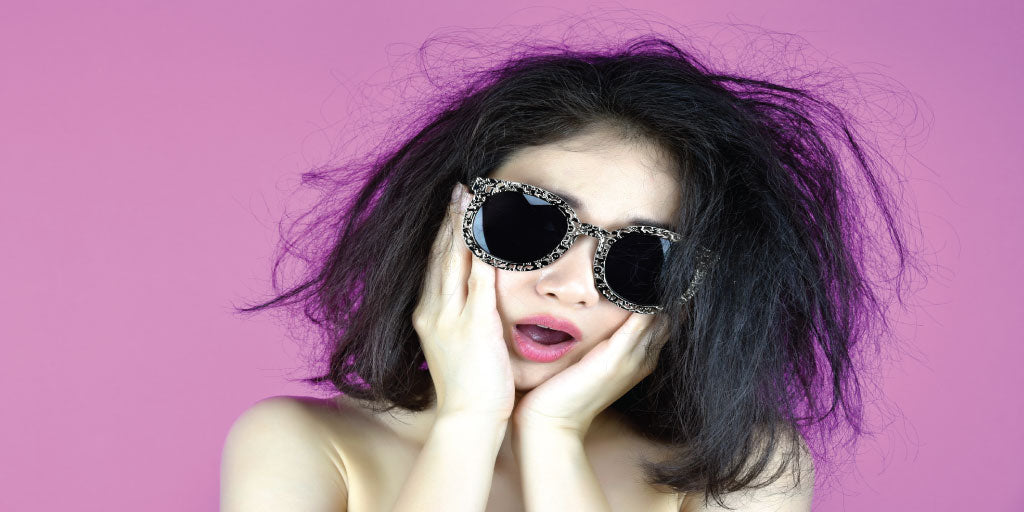Some great products to consider when caring for damaged and frizzy hair;
Blacklight Intensive Mask 200 g | Loma Fortifying Repairative Tonic 125 mL | BaBylissPRO Argan Oil Treatment 250 mL | Calura Care Masque 150 mL | BaBylissPRO Argan Restorative Mask 241 g | Loma Deep Conditioner 250 mL | Alcove Restructuring Mask 250 mL | Luseta Coconut Milk Mask 500 mL
6 Useful tips when caring for damaged & frizzy hair.
With the quarantine we have all become accustom to a messy bun, not following our typical hair routine. While we have been using less heat or product on our hair that doesn’t mean our is not damaged from it.
Your hair is customarily made of 3 different layers;
The Cuticle – Is the most outer-layer of the hair. The cuticle is often the most damaged layer of the hair4, as it is exposed to the most trauma. When the cuticle is damaged it cracks apart, and will not lay smooth against the hair shaft, this will cause split ends, and frizz.The Cortex – is the middle layer of the hair. The cortex is responsible for the elasticity of your hair. A very simple way to test this is to try to pull a few strands of hair to stretch them, one of three things will happen;
- It will bounce back, this means the inner proteins of your hair are healthy.
- It will stretch but not bounce back, this resembles you hair is damaged and dry, but most importantly it is lacking protein.
- It will break, this shows your hair is very damaged and has little to no protein remaining.
The Cortex is very important to your hair, the cuticle serves as a shield to the cortex, if the cuticle is damaged and begins to crack apart, the cortex is then exposed, when your hair enters this stage of damage, it is very hard to heal.
The Medulla – is the center layer of the hair. Not everyone has this layer, people with thicker, course, often curly hair tend to have this layer, while finer thin hair tends not to. The medulla does not get damaged, nor is it something we need to worry about.
While having damaged frizzy hair can be exhausting, and unmanageable, here are some useful tips and tools we can offer you today.
- Lower the heat!
If you absolutely must blow dry your hair, try using the dryer set to the cold temperature, it may take longer, but you hair will thank you! Turning down your flat iron or curling iron as well, they do not need to be set at maximum temperature, and use a heat protectant. Heat damage is one of the more common types of damage.
- Use a mask or Deep Conditioner.
The right masks or deep conditioners contain high concentrated amounts of proteins, when put on your hair they absorb into your hair. A common misconception with masks or deep conditioners is the amount of time they are left on the hair, you can, and depending on how damaged your hair is, you should, leave it on your hair for a few hours, even overnight. This allows you hair to truly absorb the proteins and nutrients.
- Choosing the right Shampoo and Conditioner
Ensuring you have the correct Shampoo and Conditioner is critical, they are not all the same. Shampoo’s are meant to remove a build up of oil’s and product’s from the hair, unfortunately to do this a lot of those shampoos contain sulfates. Your hair needs oil, especially the oil it creates, sulfates remove to much oil, this can leave your hair dry and brittle. A very common mistake with shampoo is over lathering, you do not need to lather the end’s of your hair, just your scalp. For the end’s of your hair use soft pressure with little to no lathering, and simply allow the shampoo to do it’s job. Conditioner’s much like shampoo’s are very important, conditioner’s job is to put the oil’s back into the hair. When you are using conditioner you do not want to apply it to the scalp, as it can cause your hair to look and feel oily fast, you simply want to apply the conditioner to the mid’s, and end’s of your hair. When looking for a good conditioner you want to consider two things;
- The ingredients, you will want to avoid Parabens or Alcohols.
- The use, there are many different kinds of conditioner, to ones that are used daily, to very nourishing ones. Assessing your hair, and your routine is very important in selecting the correct conditioner, to ensure your hair is getting what it needs.
- Wet Hair Care
Unbeknownst to most of us, we do not care for our hair when it is wet properly at all! Very simple common things like how you put your hair in your towel, the towel its self, and worst of all brushing your hair while its wet, are very damaging! When your hair is wet it is in its most fragile state, being to rough with the your hair when its wet will cause it to snap. Surprisingly this does not refer to pulling or styling, but something as simple as brushing your hair. If you want to detangle your hair while it is wet, using a good leave-in conditioner, and a wide tooth comb, is best this will eliminate a lot of tension on your hair, which in turn, will eliminate breakage. Another thing to consider with wet hair is your towel, you should never jostle your hair with a towel, as this causes a lot of damage to your cuticle, which will cause a lot of frizz. The best thing you can do for your hair while it is drying is wrap it gently in an old cotton t-shirt, and just allow it to dry, before brushing or styling.
- Sleeping Care
Yet another big misconception for your hair care routine, is how you prep it for bedtime. A lot of us are guilty for doing nothing, or sleeping with our hair in a bun or ponytail, or even wet. While it is not bad to sleep on wet hair, it can be bad to sleep with your hair in a ponytail or bun (especially if its wet). Having your hair in a ponytail or bun, put’s a lot of tension on your hair, the worst is where the elastic sits on the hair. Most often your hair will snap where the elastic holds it, from the constant tension. The best way to prep your hair for sleep is to loosely braid it, especially if its wet, this will eliminate any tension points on the hair. If your hair is dry you can still sleep with your hair in a bun or a ponytail, try using a scrunchie to hold the hair, as they are often more gentle on the hair. Another very important thing for sleeping is a satin pillow case, both beneficial for your hair and your skin. Satin is not abrasive, it will allow your hair and skin to retain their natural oil’s and will eliminate friction on the pillow case.
- The Split Ender Pro 2
The miracle machine! While this tool can look and sound very daunting, it is an amazing tool that allows you to trim your split ends, at home, by your self! You simply wash and blow dry your hair, taking small sections pass the Split Ender Pro 2 down your hair. The hair plate In the Split Ender bends your hair, so the blades only cut 1/8” to 1-4” off. It removes all the split ends from the hair, which is the most damaged part of your hair leaving the length and health!



